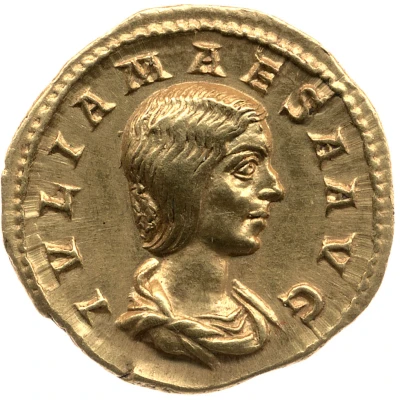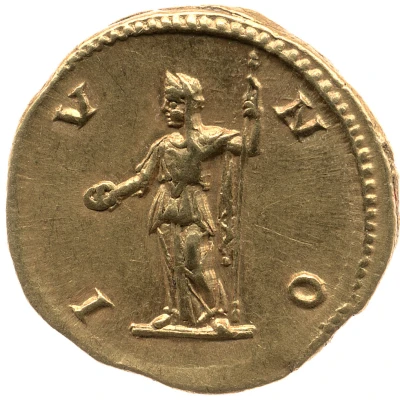


© Trustees of the British Museum
Aureus - Julia Maesa IVNO; Juno
| Gold | 6.1 g | 21 mm |
| Issuer | Rome › Roman Empire (27 BC - 395 AD) |
|---|---|
| Emperor | Elagabalus (Sextus Varius Avitus Basianus) (218-222) |
| Type | Standard circulation coin |
| Years | 218-222 |
| Value | Aureus (25⁄2) |
| Currency | Antoninianus, Reform of Caracalla (AD 215 – 301) |
| Composition | Gold |
| Weight | 6.1 g |
| Diameter | 21 mm |
| Shape | Round (irregular) |
| Technique | Hammered |
| Demonetized | Yes |
| Updated | 2024-10-05 |
| Numista | N#276921 |
|---|---|
| Rarity index | 100% |
Reverse
Juno, veiled, draped, standing left, holding patera in extended right hand and sceptre in left hand.
Script: Latin
Lettering: IVNO
Translation:
Iuno.
Juno.
Comment
Mass varies: 6.08–6.38 g;Example of this type:
Trustees of the British Museum
Source:
Online Coins of the Roman Empire (OCRE)
Interesting fact
The Aureus was a gold coin used in the Roman Empire, and the Julia Maesa coin is a rare example of this denomination. It was minted during the reign of Emperor Elagabalus, who was known for his extravagance and decadence. The coin features an image of Julia Maesa, the emperor's grandmother, on the obverse (front side), and an image of the goddess Juno on the reverse (back side). The coin's weight of 6.1 grams is significant because it was a standard weight for gold coins during that time period, and it indicates that the coin was made of pure gold. It's interesting to note that the Julia Maesa coin is a rare surviving example of Roman coinage from that time period, and it provides valuable insight into the economic and political conditions of the Roman Empire during the 3rd century AD.